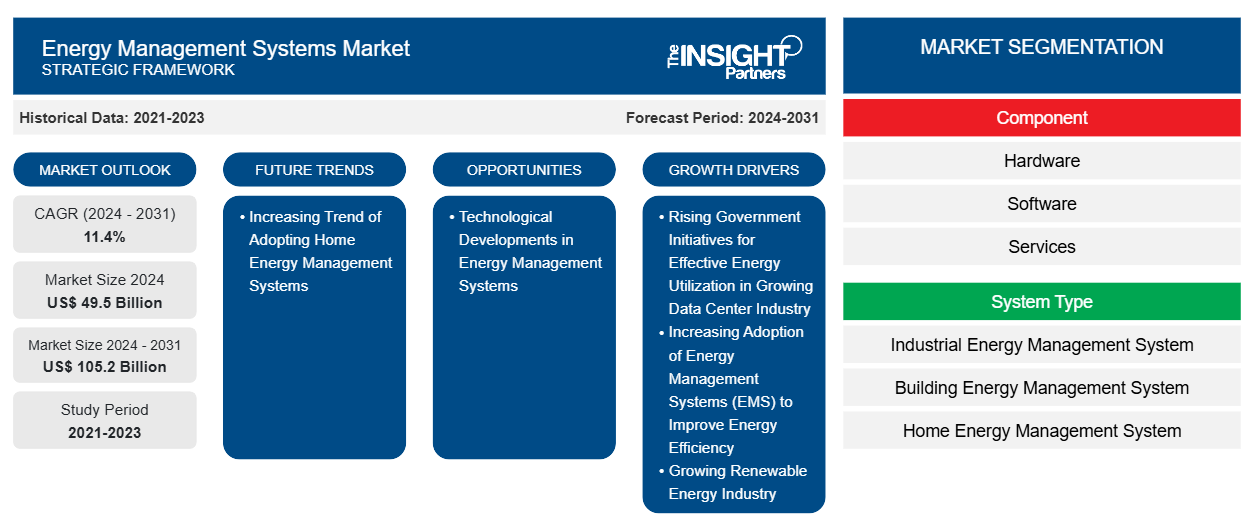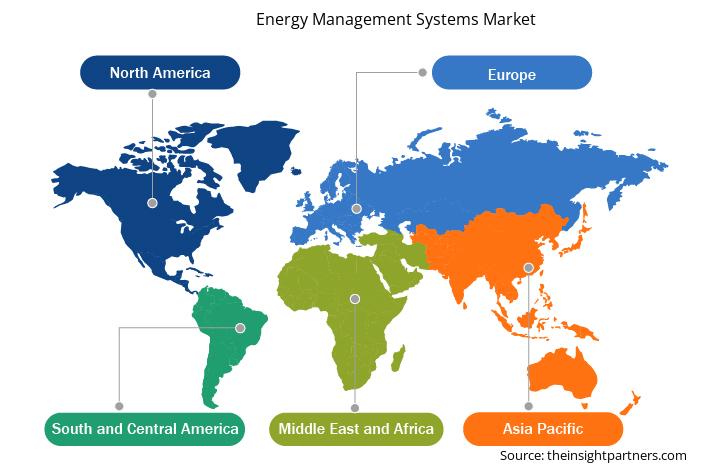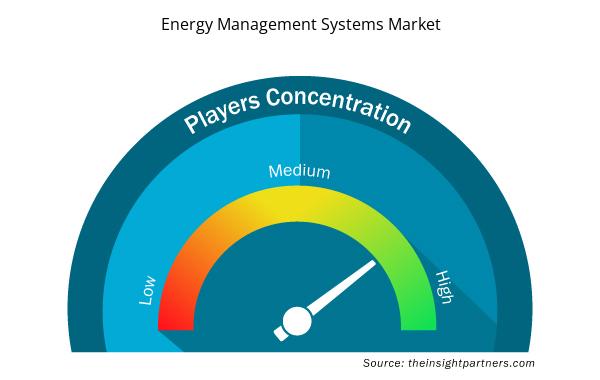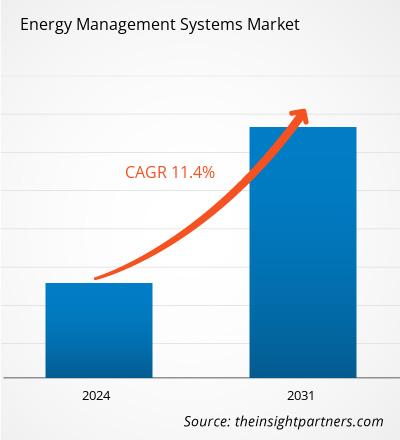من المتوقع أن يصل حجم سوق أنظمة إدارة الطاقة إلى 105.2 مليار دولار أمريكي بحلول عام 2031، مقارنةً بـ 49.5 مليار دولار أمريكي في عام 2024. ومن المتوقع أن يسجل السوق معدل نمو سنوي مركب قدره 11.4% خلال الفترة 2024-2031. ومن المرجح أن تُسهم التطورات التكنولوجية المتنامية في أنظمة إدارة الطاقة في ظهور اتجاهات جديدة في السوق خلال السنوات القادمة.
تحليل سوق أنظمة إدارة الطاقة
يزداد اعتماد أنظمة إدارة الطاقة في مختلف القطاعات، مثل التصنيع، والسيارات، والاتصالات وتكنولوجيا المعلومات، والقطاعات السكنية والتجارية، والطاقة والمرافق. يُعد نظام إدارة الطاقة الذكي (SEMS) إحدى هذه التقنيات التي تستفيد من اتصال إنترنت الأشياء (IoT) لتتبع استهلاك الطاقة وقياسه والتحكم فيه وتحسينه في المباني أو المجمعات المكتبية، مما يُسهم في إدارة استهلاك الطاقة بكفاءة في مختلف القطاعات. ومن المتوقع أن يُشجع تزايد المبادرات الحكومية والخاصة الرامية إلى الحفاظ على الطاقة، وتحقيق أهداف الاستدامة، وتقديم حوافز لخفض انبعاثات الكربون للجهات الفاعلة في الصناعة وغيرها من العملاء السكنيين والتجاريين حول العالم، الشركات العاملة في سوق أنظمة إدارة الطاقة على تبني التطورات الاستراتيجية الرئيسية، مثل تطوير المنتجات، وعمليات الدمج، والشراكات، والتعاون. على سبيل المثال، في مايو 2024، قدمت شركة سيمنز للبنية التحتية الذكية وإمبوريا حلاً لمراقبة الطاقة المنزلية باسم "إنهاب إنرجي مونيتور". يُقلل هذا الحل الجديد من استهلاك الطاقة في المنازل من خلال المراقبة المستمرة لاستخدامها. في أبريل 2024، أطلقت شركة باورلي (شركة متخصصة في إدارة الطاقة المنزلية) خدمة باورلاي لايف لمساعدة شركات المرافق على إنشاء محطات طاقة افتراضية على مستوى المنزل، مما يُمكّن العملاء من مراقبة استهلاك الأجهزة، ويتيح التنبؤ الدقيق بالأحمال والتحكم فيها.
نظرة عامة على سوق أنظمة إدارة الطاقة
نظام إدارة الطاقة هو حل شامل لمراقبة استهلاك الطاقة والتحكم فيه وتحسينه داخل منشأة أو مؤسسة أو عبر مواقع متعددة. يدمج هذا النظام الأجهزة والبرامج وأدوات التحليل لتوفير رؤى آنية حول أنماط استهلاك الطاقة، وتحديد فرص التحسين، وتنفيذ استراتيجيات لتحسين كفاءة الطاقة والاستدامة. تشمل الميزات الأساسية لأنظمة إدارة الطاقة جمع البيانات، والمراقبة، والأتمتة والتحكم، والاستجابة للطلب وإدارة الأحمال، وتحليل استهلاك الطاقة وإعداد التقارير عنه، وتكامل موارد الطاقة الموزعة. يشمل المستخدمون النهائيون الرئيسيون لأنظمة إدارة الطاقة حول العالم قطاعات التصنيع، والمباني السكنية والتجارية، وقطاع الطاقة والمرافق، ومراكز البيانات، وتجارة التجزئة، وقطاع الضيافة، والمنشآت الصناعية (بما يتجاوز قطاع التصنيع).
تُعدّ المستشعرات وأجهزة القياس مكونات أساسية في كل نظام إدارة طاقة. تُوفّر هذه الأدوات بيانات دقيقة عن استهلاك الطاقة في الموقع والمبنى والغرفة والمرافق، مما يُتيح تحليلًا مُفصّلًا لتحديد أوجه القصور واستهداف مجالات التحسين. تقيس المستشعرات المتطورة مُتغيّرات مثل درجة الحرارة والرطوبة وأداء الجهاز لتوفير رؤية شاملة لاستهلاك الطاقة. تستخدم منصات إدارة الطاقة الحديثة خوارزميات الذكاء الاصطناعي والتعلم الآلي للتنبؤ باحتياجات الطاقة، وتحديد الاتجاهات، وتسليط الضوء على أوجه القصور. كما تتنبأ هذه التقنيات بأنماط استهلاك الطاقة، مما يُتيح اتخاذ قرارات أكثر ذكاءً.
تشمل العوامل الرئيسية التي تُحفّز نمو سوق أنظمة إدارة الطاقة المبادرات الحكومية الرامية إلى الاستخدام الفعال للطاقة في قطاع مراكز البيانات المتنامي، وتزايد اعتماد هذه الأنظمة لتحسين كفاءة الطاقة، ونمو قطاع الطاقة المتجددة. ومع ذلك، من المتوقع أن تُعيق عوائق تنفيذ مشاريع أنظمة إدارة الطاقة نمو السوق. ومن المتوقع أن تُتيح التطورات التكنولوجية في أنظمة إدارة الطاقة فرصًا للشركات العاملة في السوق خلال فترة التوقعات. علاوة على ذلك، من المتوقع أن يؤثر التوجه المتزايد نحو أنظمة إدارة الطاقة المنزلية على مسار نمو السوق بين عامي 2024 و2031.
قم بتخصيص هذا التقرير ليناسب متطلباتك
ستحصل على تخصيص لأي تقرير - مجانًا - بما في ذلك أجزاء من هذا التقرير، أو تحليل على مستوى الدولة، وحزمة بيانات Excel، بالإضافة إلى الاستفادة من العروض والخصومات الرائعة للشركات الناشئة والجامعات
سوق أنظمة إدارة الطاقة:

- احصل على أهم اتجاهات السوق الرئيسية لهذا التقرير.ستتضمن هذه العينة المجانية تحليل البيانات، بدءًا من اتجاهات السوق وحتى التقديرات والتوقعات.
محركات وفرص سوق أنظمة إدارة الطاقة
اتجاه متزايد نحو اعتماد أنظمة إدارة الطاقة المنزلية
نظام إدارة الطاقة المنزلية يراقب ويحسّن تدفق الطاقة داخل المنزل لتحقيق هدف محدد. تُعزز اللوائح الطموحة المتعلقة باستهلاك الطاقة في القطاع السكني بشكل متزايد أنظمة إدارة الطاقة المنزلية. على سبيل المثال، طُبّق معيار الاتحاد الأوروبي للأسطح الشمسية، مثل توجيه أداء الطاقة للمباني، في أوائل مايو 2023، ومن المتوقع أن يُركّب ما بين 150 و200 جيجاواط من الطاقة الشمسية الإضافية على الأسطح في الاتحاد الأوروبي بين عامي 2026 و2030، وهو ما يكفي لتزويد 56 مليون نسمة بالطاقة. هذا يعني أنه سيتم استغلال الإمكانات الكاملة للطاقة الكهروضوئية على الأسطح تدريجيًا في السنوات القادمة.
صناعة الطاقة المتجددة المتنامية
يُعدّ توليد الطاقة باستخدام الوقود الأحفوري مساهمًا رئيسيًا في انبعاثات غازات الاحتباس الحراري التي تُؤدي إلى تغيّر المناخ. ولذلك، تُركّز العديد من الحكومات حول العالم على تقليل بصمتها الكربونية والتحول نحو الطاقة النظيفة، مما يدفعها إلى الاستثمار في إنتاج الطاقة الخضراء. ويتزايد استخدام الطاقة الشمسية وطاقة الرياح نتيجةً للتركيز المتزايد على استخدام الطاقة النظيفة والخضراء، وتزايد المخاوف بشأن تغيّر المناخ، وتزايد المبادرات الحكومية لتشجيع استخدام الطاقة المتجددة. ووفقًا لوكالة الطاقة الدولية (IEA)، من المتوقع أن يرتفع توليد الكهرباء المتجددة عالميًا إلى أكثر من 17,000 تيراواط/ساعة بحلول نهاية هذا العقد، بزيادة تُقارب 90% عن عام 2023؛ ومن المتوقع أن يُلبّي هذا احتياجات الصين والولايات المتحدة الأمريكية من الكهرباء مجتمعةً في عام 2030. ومن المتوقع تحقيق العديد من الإنجازات في مجال الطاقة المتجددة خلال السنوات الخمس المقبلة. ففي عام 2025، من المتوقع أن يتجاوز توليد الكهرباء من الطاقات المتجددة توليد الطاقة من الفحم. وفي عام 2026، من المتوقع أن يتجاوز توليد الكهرباء من طاقة الرياح والطاقة الشمسية توليد الطاقة النووية. ومن المتوقع أن يتجاوز توليد الكهرباء من الطاقة الشمسية الكهروضوئية في عام 2029 توليد الطاقة الكهرومائية ويصبح أكبر مصدر للطاقة المتجددة في العالم - وينطبق الأمر نفسه على توليد طاقة الرياح الذي من المتوقع أن يتجاوز الطاقة الكهرومائية بحلول عام 2030.
تحليل تجزئة تقرير سوق أنظمة إدارة الطاقة
القطاعات الرئيسية التي ساهمت في اشتقاق تحليل سوق أنظمة إدارة الطاقة هي المكونات ونوع النظام والصناعة النهائية.
- من حيث المكونات، يُصنف السوق إلى أجهزة، وبرامج، وخدمات. وقد هيمن قطاع الأجهزة على السوق في عام ٢٠٢٤.
- بناءً على نوع النظام، يُقسّم السوق إلى أنظمة إدارة الطاقة الصناعية، وأنظمة إدارة طاقة المباني، وأنظمة إدارة طاقة المنازل. وقد هيمن قطاع أنظمة إدارة الطاقة الصناعية على السوق في عام ٢٠٢٤.
- بناءً على قطاع الاستخدام النهائي، يُقسّم السوق إلى قطاعات الطاقة والمرافق، والتصنيع، والاتصالات وتكنولوجيا المعلومات، والقطاعات السكنية والتجارية، وغيرها. وسيُهيمن قطاع التصنيع على السوق في عام ٢٠٢٤.
تحليل حصة سوق أنظمة إدارة الطاقة حسب المنطقة الجغرافية
يُقسّم سوق أنظمة إدارة الطاقة إلى خمس مناطق رئيسية: أمريكا الشمالية، وأوروبا، وآسيا والمحيط الهادئ، والشرق الأوسط وأفريقيا، وأمريكا الجنوبية والوسطى. وقد هيمنت أمريكا الشمالية على السوق في عام 2024، تلتها أوروبا وآسيا والمحيط الهادئ.
تتمتع أوروبا بصناعة تصنيع راسخة تستخدم تقنيات متطورة، مثل الأتمتة والروبوتات وإنترنت الأشياء الصناعي (IoT) والصناعة 4.0. في أوروبا، خلقت التطورات التكنولوجية سوقًا شديد التنافسية لأنظمة إدارة الطاقة. تُعد أوروبا واحدة من أهم شركات تصنيع السيارات في العالم. إن وجود شركات تصنيع سيارات رائدة عالميًا مثل فولكس فاجن إيه جي وستيلانتس إن في ومرسيدس بنز جروب إيه جي وبايريش موتورين فيرك إيه جي ورينو إس إيه هو ما يدفع نمو الصناعة. تتطلب هذه الشركات المصنعة الكهرباء أو الطاقة للعمليات السلسة، مما يغذي اعتماد أنظمة إدارة الطاقة. ألمانيا هي أكبر اقتصاد في أوروبا وتضم العديد من القطاعات الصناعية الرائدة، بما في ذلك السيارات والطيران والإلكترونيات والكيماويات وتجهيز الأغذية. وفقًا لرابطة مصنعي السيارات الأوروبية (ACEA)، وصلت تسجيلات السيارات الجديدة في ألمانيا إلى حوالي 2.84 مليون وحدة في عام 2023 من 2.65 مليون وحدة في عام 2022، وهو ما يمثل نموًا بنسبة ~ 7٪. تُعدّ ألمانيا أكبر مركز لصناعة السيارات في أوروبا، حيث تُمثّل أكثر من 25% من إجمالي إنتاج سيارات الركاب وحوالي 20% من إجمالي تسجيلات المركبات الجديدة في عام 2023. وكانت ألمانيا أكبر مُصنّع لسيارات الركاب في أوروبا في عام 2023؛ حيث سجّلت مصانع التصنيع في البلاد تصنيع ما يقرب من 3.10 مليون وحدة، بزيادة سنوية بلغت حوالي 17%. تشير هذه البيانات إلى أن ألمانيا تمتلك منظومة راسخة لتصنيع السيارات، مما يُغذّي الطلب على الكهرباء في عمليات التصنيع أو المعالجة، مما يُعزّز بدوره اعتماد أنظمة إدارة الطاقة.
رؤى إقليمية حول سوق أنظمة إدارة الطاقة
قام محللو إنسايت بارتنرز بشرح شامل للاتجاهات والعوامل الإقليمية المؤثرة في سوق أنظمة إدارة الطاقة خلال فترة التوقعات. ويناقش هذا القسم أيضًا قطاعات سوق أنظمة إدارة الطاقة ونطاقها الجغرافي في أمريكا الشمالية، وأوروبا، وآسيا والمحيط الهادئ، والشرق الأوسط وأفريقيا، وأمريكا الجنوبية والوسطى.

- احصل على البيانات الإقليمية المحددة لسوق أنظمة إدارة الطاقة
نطاق تقرير سوق أنظمة إدارة الطاقة
| سمة التقرير | تفاصيل |
|---|---|
| حجم السوق في عام 2024 | 49.5 مليار دولار أمريكي |
| حجم السوق بحلول عام 2031 | 105.2 مليار دولار أمريكي |
| معدل النمو السنوي المركب العالمي (2024 - 2031) | 11.4% |
| البيانات التاريخية | 2021-2023 |
| فترة التنبؤ | 2024-2031 |
| القطاعات المغطاة | حسب المكون
|
| المناطق والدول المغطاة | أمريكا الشمالية
|
| قادة السوق وملفات تعريف الشركات الرئيسية |
|
كثافة اللاعبين في سوق أنظمة إدارة الطاقة: فهم تأثيرها على ديناميكيات الأعمال
يشهد سوق أنظمة إدارة الطاقة نموًا سريعًا، مدفوعًا بتزايد طلب المستخدمين النهائيين نتيجةً لعوامل مثل تفضيلات المستهلكين المتطورة، والتقدم التكنولوجي، وزيادة الوعي بفوائد المنتج. ومع تزايد الطلب، تعمل الشركات على توسيع عروضها، والابتكار لتلبية احتياجات المستهلكين، والاستفادة من الاتجاهات الناشئة، مما يُعزز نمو السوق.
تشير كثافة اللاعبين في السوق إلى توزيع الشركات العاملة في سوق أو قطاع معين. وتشير إلى عدد المنافسين (اللاعبين في السوق) الموجودين في سوق معين نسبةً إلى حجمه أو قيمته السوقية الإجمالية.
الشركات الرئيسية العاملة في سوق أنظمة إدارة الطاقة هي:
- شركة أي بي بي
- شركة شنايدر إلكتريك SE
- شركة جنرال إلكتريك
- شركة هانيويل الدولية
- شركة سيمنز ايه جي
- شركة آي بي إم
إخلاء المسؤولية : الشركات المذكورة أعلاه ليست مرتبة بأي ترتيب معين.

- احصل على نظرة عامة على أهم اللاعبين الرئيسيين في سوق أنظمة إدارة الطاقة
أخبار سوق أنظمة إدارة الطاقة والتطورات الأخيرة
يُقيّم سوق أنظمة إدارة الطاقة بجمع بيانات نوعية وكمية بعد البحث الأولي والثانوي، والتي تشمل منشورات الشركات المهمة، وبيانات الجمعيات، وقواعد البيانات. فيما يلي بعض التطورات الرئيسية في سوق أنظمة إدارة الطاقة:
- أبرمت شركة شنايدر إلكتريك، الرائدة في مجال التحول الرقمي لإدارة الطاقة والأتمتة من الجيل التالي، شراكة استراتيجية مع مطار نويدا الدولي لتقديم حلول إدارة المباني والطاقة. ومن خلال هذا التعاون، ستطرح شنايدر إلكتريك حلولاً متكاملة لإدارة المباني، تشمل نظام سكادا الكهربائي ونظام إدارة التوزيع المتقدم، بهدف تعزيز الكفاءة التشغيلية والاستدامة في المطار. (المصدر: شنايدر إلكتريك، بيان صحفي، أكتوبر 2024)
- أطلقت شركة ABB نظام ABB Ability OPTIMAX® 6.4، أحدث إصدار من نظامها الرائد لإدارة وتحسين الطاقة الرقمية، لتوفير تحكم منسق في الأصول والعمليات الصناعية المتعددة، لتحسين كفاءة الطاقة، وتقليل الانبعاثات، ودعم جهود إزالة الكربون. (المصدر: ABB، بيان صحفي، يونيو 2024)
تغطية تقرير سوق أنظمة إدارة الطاقة والنتائج المتوقعة
يوفر تقرير "حجم سوق أنظمة إدارة الطاقة والتوقعات (2021-2031)" تحليلاً مفصلاً للسوق يغطي المجالات المذكورة أدناه:
- حجم سوق أنظمة إدارة الطاقة وتوقعاته على المستويات العالمية والإقليمية والوطنية لجميع قطاعات السوق الرئيسية التي يغطيها النطاق
- اتجاهات سوق أنظمة إدارة الطاقة بالإضافة إلى ديناميكيات السوق مثل المحركات والقيود والفرص الرئيسية
- تحليل مفصل لـ PEST و SWOT
- تحليل سوق أنظمة إدارة الطاقة يغطي اتجاهات السوق الرئيسية والإطار العالمي والإقليمي والجهات الفاعلة الرئيسية واللوائح والتطورات الأخيرة في السوق
- تحليل المشهد الصناعي والمنافسة الذي يغطي تركيز السوق، وتحليل خريطة الحرارة، واللاعبين البارزين، والتطورات الأخيرة لسوق أنظمة إدارة الطاقة
- ملفات تعريف الشركة التفصيلية
- التحليل التاريخي (سنتان)، السنة الأساسية، التوقعات (7 سنوات) مع معدل النمو السنوي المركب
- تحليل PEST و SWOT
- حجم السوق والقيمة / الحجم - عالميًا وإقليميًا وقطريًا
- الصناعة والمنافسة
- مجموعة بيانات Excel



Report Coverage
Revenue forecast, Company Analysis, Industry landscape, Growth factors, and Trends

Segment Covered
This text is related
to segments covered.

Regional Scope
North America, Europe, Asia Pacific, Middle East & Africa, South & Central America

Country Scope
This text is related
to country scope.
الأسئلة الشائعة
The energy management system market is expected to reach US$ 105,154.28 million by 2031.
Increasing Trend of Adopting Home Energy Management Systems are one of the major future trends
The key players operating in the energy management system market include ABB; Schneider Electric SE; General Electric Company; Honeywell International Inc.; Siemens AG; IBM Corporation; Johnson Controls, Inc.; Emerson Electric Co.; Eaton Corporation; and Mitsubishi Electric Corporation.
The energy management system market was valued at US$ 49,498.32 million in 2024; it is expected to register a CAGR of 11.4% during 2024–2031.
Rising Government Initiatives for Effective Energy Utilization in Growing Data Center Industry, Increasing Adoption of Energy Management Systems (EMS) to Improve Energy Efficiency, Growing Renewable Energy Industry are some of the major drivers
Trends and growth analysis reports related to Energy and Power : READ MORE..
The List of Companies - Energy Management Systems Market
- ABB
- Schneider Electric SE
- General Electric Company
- Honeywell International Inc.
- Siemens AG
- IBM Corporation
- Johnson Controls, Inc.
- Emerson Electric Co.
- Eaton Corporation
- Mitsubishi Electric Corporation
The Insight Partners performs research in 4 major stages: Data Collection & Secondary Research, Primary Research, Data Analysis and Data Triangulation & Final Review.
- Data Collection and Secondary Research:
As a market research and consulting firm operating from a decade, we have published and advised several client across the globe. First step for any study will start with an assessment of currently available data and insights from existing reports. Further, historical and current market information is collected from Investor Presentations, Annual Reports, SEC Filings, etc., and other information related to company’s performance and market positioning are gathered from Paid Databases (Factiva, Hoovers, and Reuters) and various other publications available in public domain.
Several associations trade associates, technical forums, institutes, societies and organization are accessed to gain technical as well as market related insights through their publications such as research papers, blogs and press releases related to the studies are referred to get cues about the market. Further, white papers, journals, magazines, and other news articles published in last 3 years are scrutinized and analyzed to understand the current market trends.
- Primary Research:
The primarily interview analysis comprise of data obtained from industry participants interview and answers to survey questions gathered by in-house primary team.
For primary research, interviews are conducted with industry experts/CEOs/Marketing Managers/VPs/Subject Matter Experts from both demand and supply side to get a 360-degree view of the market. The primary team conducts several interviews based on the complexity of the markets to understand the various market trends and dynamics which makes research more credible and precise.
A typical research interview fulfils the following functions:
- Provides first-hand information on the market size, market trends, growth trends, competitive landscape, and outlook
- Validates and strengthens in-house secondary research findings
- Develops the analysis team’s expertise and market understanding
Primary research involves email interactions and telephone interviews for each market, category, segment, and sub-segment across geographies. The participants who typically take part in such a process include, but are not limited to:
- Industry participants: VPs, business development managers, market intelligence managers and national sales managers
- Outside experts: Valuation experts, research analysts and key opinion leaders specializing in the electronics and semiconductor industry.
Below is the breakup of our primary respondents by company, designation, and region:

Once we receive the confirmation from primary research sources or primary respondents, we finalize the base year market estimation and forecast the data as per the macroeconomic and microeconomic factors assessed during data collection.
- Data Analysis:
Once data is validated through both secondary as well as primary respondents, we finalize the market estimations by hypothesis formulation and factor analysis at regional and country level.
- Macro-Economic Factor Analysis:
We analyse macroeconomic indicators such the gross domestic product (GDP), increase in the demand for goods and services across industries, technological advancement, regional economic growth, governmental policies, the influence of COVID-19, PEST analysis, and other aspects. This analysis aids in setting benchmarks for various nations/regions and approximating market splits. Additionally, the general trend of the aforementioned components aid in determining the market's development possibilities.
- Country Level Data:
Various factors that are especially aligned to the country are taken into account to determine the market size for a certain area and country, including the presence of vendors, such as headquarters and offices, the country's GDP, demand patterns, and industry growth. To comprehend the market dynamics for the nation, a number of growth variables, inhibitors, application areas, and current market trends are researched. The aforementioned elements aid in determining the country's overall market's growth potential.
- Company Profile:
The “Table of Contents” is formulated by listing and analyzing more than 25 - 30 companies operating in the market ecosystem across geographies. However, we profile only 10 companies as a standard practice in our syndicate reports. These 10 companies comprise leading, emerging, and regional players. Nonetheless, our analysis is not restricted to the 10 listed companies, we also analyze other companies present in the market to develop a holistic view and understand the prevailing trends. The “Company Profiles” section in the report covers key facts, business description, products & services, financial information, SWOT analysis, and key developments. The financial information presented is extracted from the annual reports and official documents of the publicly listed companies. Upon collecting the information for the sections of respective companies, we verify them via various primary sources and then compile the data in respective company profiles. The company level information helps us in deriving the base number as well as in forecasting the market size.
- Developing Base Number:
Aggregation of sales statistics (2020-2022) and macro-economic factor, and other secondary and primary research insights are utilized to arrive at base number and related market shares for 2022. The data gaps are identified in this step and relevant market data is analyzed, collected from paid primary interviews or databases. On finalizing the base year market size, forecasts are developed on the basis of macro-economic, industry and market growth factors and company level analysis.
- Data Triangulation and Final Review:
The market findings and base year market size calculations are validated from supply as well as demand side. Demand side validations are based on macro-economic factor analysis and benchmarks for respective regions and countries. In case of supply side validations, revenues of major companies are estimated (in case not available) based on industry benchmark, approximate number of employees, product portfolio, and primary interviews revenues are gathered. Further revenue from target product/service segment is assessed to avoid overshooting of market statistics. In case of heavy deviations between supply and demand side values, all thes steps are repeated to achieve synchronization.
We follow an iterative model, wherein we share our research findings with Subject Matter Experts (SME’s) and Key Opinion Leaders (KOLs) until consensus view of the market is not formulated – this model negates any drastic deviation in the opinions of experts. Only validated and universally acceptable research findings are quoted in our reports.
We have important check points that we use to validate our research findings – which we call – data triangulation, where we validate the information, we generate from secondary sources with primary interviews and then we re-validate with our internal data bases and Subject matter experts. This comprehensive model enables us to deliver high quality, reliable data in shortest possible time.

 احصل على عينة مجانية لهذا التقرير
احصل على عينة مجانية لهذا التقرير